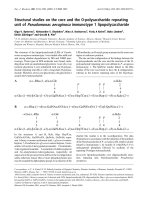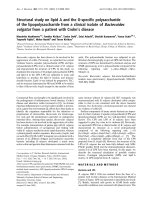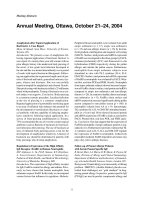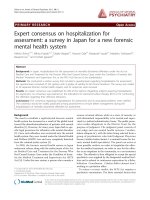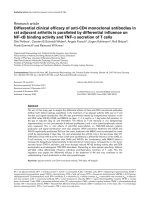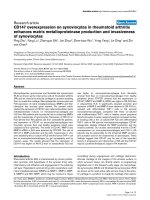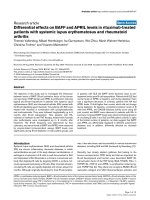Báo cáo y học: "Expert consensus on hospitalization for assessment: a survey in Japan for a new forensic mental health system" pot
Bạn đang xem bản rút gọn của tài liệu. Xem và tải ngay bản đầy đủ của tài liệu tại đây (328.01 KB, 11 trang )
PRIMARY RESEARCH Open Access
Expert consensus on hospitalization for
assessment: a survey in Japan for a new forensic
mental health system
Akihiro Shiina
1,2*†
, Mihisa Fujisaki
1,2†
, Takako Nagata
3†
, Yasunori Oda
4†
, Masatoshi Suzuki
5†
, Masahiro Yoshizawa
6†
,
Masaomi Iyo
7†
and Yoshito Igarashi
2†
Abstract
Background: In Japan, hospitalization for the assessment of mentally disordered offenders under the Act on
Medical Care and Treatment for the Persons Who Had Caused Serious Cases under the Condition of Insanity (the
Medical Treatment and Supervision Act, or the MTS Act) has yet to be standardized.
Methods: We conducted a written survey that included a questionnaire regarding hospitalization for assessment;
the questionnaire consisted of 335 options with 9 grades of validity for 60 clinical situations. The survey was mailed
to 50 Japanese forensic mental health experts, and 42 responses were received.
Results: An expert consensus was established for 299 of the options. Regarding subjects requiring hospitalization
for assessment, no consensus was reached on the indications for electroconvulsive therapy (ECT) or for confronting
the offenders regarding their offensive behaviors.
Conclusions: The consensus regarding hospitalization for assessment and its associated problems were clarified.
The consensus should be widely publicized among practit ioners to ensure better management during the
hospitalization of mentally disordered offenders for assessment.
Background
The need to establish a sophisticated forensic mental
health system has increased as a result of the global trend
toward the deinstitutionalization of patients with mental
disorders [1]. However, for many years, Japan had no spe-
cific legal provisions for offenders with mental disorders
[2]. Once such offenders were entrusted into the mental
health system, they were treated under the Mental Health
and Welfare (MHW) Law and were completely detached
from the criminal justice system [3].
In 2005, the forensic mental health system in Japan
underwent reform along with the enforcement of the Act
on Medical Care and Treatment for the Persons Who
Had Caused Serious Cases under the Condition of Insan-
ity: the Medical Treatment and Supervision Act (MTS
Act) [4]. Under this new system, a person who commits a
serious criminal offense whileinastateofinsanityor
with diminished responsibility is be treated and super-
vised in a judicial administrative frame. The public prose-
cutor makes allegations t o the District Court for the
purpose of judgment. The judgment panel consists of
one judge and one mental health reviewer (‘ seishin-
hoken-shinpa n-in’), with the latter b eing selected from a
group of psychiatrists who hold Judgment Physicia n
license (’seishin-hoken-hantei-i’ a national license for for-
ensic mental health specialists). The panel can arrive at
three possible verdicts: an order to hospitalize the offen-
der for medical treatment, an o rder to care for the offen-
der as an outpatient in the community, or a no-treatment
order. The offender is then obligated to accept the special
psychiatric care supplied by the designated medical facil-
ities and to submit to continuous supervision by a Reha-
bilitation Coordinator (’ shakai-fukki-chousei-kan’ )
working in a probation office.
To return a correct verdict, the MTS Act requires a
psychiatric examination. The three essenti al fac tors that
* Correspondence:
† Contributed equally
1
Department of Psychiatry, Chiba University Hospital, Chiba, Japan
Full list of author information is available at the end of the article
Shiina et al. Annals of General Psychiatry 2011, 10:11
/>© 2011 Shiina et al; licensee BioMed Central Ltd. This is an Open Access article distributed under the terms of the Creative Commons
Attribution License (http:// creativecommons.org/licenses/by/2.0), whi ch permi ts unrestricted use, distributio n, and reproduction in
any medium, pro vide d the original work is properly cited.
must be examined when making a treatment order deci-
sion are the nature and severity o f the mental disorder
and its relationship to the offense, the offender’s ‘treat-
ability’ or responsiveness to psychiatric treatment, and
the factors that could hinder the person’s rehabilitation
and the likelihood of a second offense. The offender
should be hospitalized for 2 to 3 months during the psy-
chiatric examination, while continuing an appropriate
course of psychiatric treatment; this hospitalization per-
iod for assessment is known as ‘kantei-nyuin’ [5].
In 2008, the Japanese Government published a list of
239 Japanese mental hospitals (1.9 per 1 ,000,000 of the
population) for the purpose of hospitalization for assess-
ment of mentally disordered offenders [6]. However, the
criteria used to select these facilities are vague.
The MTS Act hardly regulates even the minimum
requirements for these facilities. Therefore, remarkable
variations exist in the hospitalization conditions for
these patients, such as in the availability of human
resources, the diagnostic and therapeutic strategies in
use, the attitudes regarding ethical issues, and the physi-
cal facilities themselves. It had been reported that about
60% to 80% of psychiatrists who treat offenders in desig-
nated inpatient facilities find problems with the written
reports of psychiatric examinations conducted and writ-
ten at the assessment stage [7]. In additio n, while it is
recommended that offenders b e treated by a m ultiple
disciplinary team (MDT) similar to that used for regular
acut e psychiatric care [8], this recommendation was not
known at 14% of the facilities that were surveyed [9].
To minimize the variation, and to impr ove the qua lity
of the assessment, we conducted a written survey that
was delivered by mail to leading Japanese forensic men-
tal health experts, and clarified the expert consensus
regarding hospitalization for assessment.
Methods
Creating the surveys
To create the questionnai re, we formed a working team
comprised of judgment physicians, psychiatrists with
experience conducting psychiatric examinations, and
doctors belonging to facilities for hospitalizations and
assessment of mentally disordered offenders. Then, w e
attempted to extract suitable questionnaire items, which
we classified as general introductory questions regarding
the characteristics of the facilities (includi ng sections on
the ‘Structure’ and ‘Staff’) or detailed questions regard-
ing management (including sections on ‘Items Before
the Start of Examination’ , ‘Diagnosis and Treatment’ ,
‘Issues Regarding Informed Consent and Forced Treat-
ment’, ‘Judgment’, and ‘Hypothetical Clinical Situations’).
We also referred to reviews in the literature to extract
questions [7,10]. We then collected the opinions of sev-
eral experts in an exploratory committee examining
‘Research on the Improvement of the System of Hospi-
talization for Assessment’ and revised the questionnaire.
Using the above-described procedure, we developed a
60-question survey with 335 options. A sample of the
questions is presented in Table 1.
Rating scale
For the 335 options in the survey, we asked the experts to
evaluate the appropriateness of the option using a 9-point
scale that was slightly modified from the format developed
by the RAND Corporation for ascertaining expert consen-
sus. To develop this rating scale, we referred to the expert
consensus guideline series developed by Expert Knowledge
Systems, LLC [10]. The anchors of the rating scale are
presented in Appendix 1.
Composition of the expert panel
We identified 50 leading Japanese experts on forensic
mental health, focusing on those individuals with exten-
sive experience managing hospitalizations for assessment
under the MTS Act. The experts were identified based
on their published research in this area and/or their par-
ticipation in the Japanese Society of Forensic Mental
Health or a related association.
Ethical issues
We reported the contents of this survey to the Ethical
Council of the Graduate School of Medicine at Chiba
University in advance, and the council declared that the
survey did not pose any ethical problems. All the
experts were given a written explanatio n of the purpose
of the survey. All respondents provided their informed
written consent to participate in the study.
Data analysis for options scored on the rating scale
For each option, we first defined the presence or
absence of a consensus as a distribution unlikely to
occurbychancebyperformingac
2
test (P <0.05)of
the distribution of the scores across three ranges of
appropriateness (7-9: appropriate; 4-6: unclear; 1-3:
inappropriate). Next, we calculated the mean and 95%
confidence interval (CI). A ca tegorical rating of first-
line, second-line, or third-line options was designated
based on the lowest category in which the CI fell, with
boundaries of 6.5 or greater for first-line (preferred)
options, 3.5 or greater but less than 6.5 for second-line
(alternate) options, and less than 3.5 for third-line
(usually inappropriate) options. Among the first line
options, we defined an option as ‘best recommendation/
essential’ if at least 50% of the experts rated it as 9. This
analysis method was adopted after reference to an
expert consensus guideline series [10].
Additionally, we extracted all the items included in the
present questionnaire that were also used in a previous
Shiina et al. Annals of General Psychiatry 2011, 10:11
/>Page 2 of 11
questionnaire survey [7] to collect the general opinions
of forensic psychiatrists. We then compared the two sets
of results to justify the present survey by evaluating the
differences between the expert consensus and the gen-
eral opinion of forensic psychiatrists.
Results
Response rate
We received responses from 42 (84%) of the 50 experts
to whom the survey was sent. Two of the respondents
were female and the rest were male. Of the 42, 2 were
professors in the psychiatric department of a university,
14 belonged to a national hospital, 20 belonged to a pre-
fectural hospital, and 6 belonged to a private hospital.
All the respondents held a national license as a Desig-
nated Physician (’ seishin-hoken-shitei-i’ )underthe
MHW Law and Judgment Physician in the MTS Act.
Furthermore, all the respondents were over 35 years of
age and had at least 10 years of experience in psychiatric
practice.
All 42 responders answered all the questions ade-
quately. No doubts or criticisms regarding the qu estion-
naire were noted by the experts.
Degree of consensus
Of the 335 options rated using the 9-point scale, a con-
sensus was reached for 299 (89.3%) options, as defined
by the presence of statistical significance using a c
2
test.
A total of 113 options were defined as first-line
options, of which 29 options were defined as ‘best
recommendation/essential’ . In all, 109 options were
defined as second-line options. The remaining 77
options were defined as third-line or usually inappropri-
ate options (see Figure 1).
Structure
This section consisted of six questions aimed at deter-
mining the necessary resources for the appropriate
administration of hospitalizations for assessment.
As facilities for the hospitalized assessment of men-
tally disordered offenders, the best r ecommendation of
the experts was the Natio nal Center Hospital, National
Center for Neurology and Psychiatry (NCH-NCNP)
(mean 8.07; 95% CI 7.62 to 8.53) or an establishment
with a specialized facility for the exclusive use of psy-
chiatric examinations (mean 8.03; 95% CI 7.53 to 8.52).
For psychiatric examinations, a psychiatric emergency
ward (mean 7.61; 95% CI 7.1 to 8.12) or, as a minimum
requirement, a psychiatric acute-phase care unit (mean
7.45; 95% CI 6.77 to 7.58) were recommende d as first-
line options. Medical examination rooms with multiple
exit doors (mean 7.64; 95% CI 7.19 to 8.1) were recom-
mended.Topreventself-hanging,ashowerwithouta
hose in each bedroom (mean 7.24; 95% CI 6.8 to 7.68)
was recommended. As for patient amenities, a television
(mean 7.07; 95% CI 6.57 to 7.58) and newspapers (mean
7.26; 95% CI 6.76 to 7.76) were recommended.
Staff
In this section, we addressed the need for human
reso urces using 16 questions. The participation of Judg-
ment Physicians (mean 8.29; 95% CI 7.93 to 8.54) and
Table 1 Sample of the survey questions
Please evaluate the following options for interventions with a subject who refuses to take medication because of a lack of insight into
his or her psychiatric disorder, but who is not seriously aggressive
(1) Explanation and persuasion 1 2 3 4 5 6 7 8 9
(2) Forced medication using liquid or oral disintegrating drugs 1 2 3 4 5 6 7 8 9
(3) Forced intravenous or intramuscular injection 1 2 3 4 5 6 7 8 9
(4) Forced depot injection 1 2 3 4 5 6 7 8 9
(5) Masked medication 1 2 3 4 5 6 7 8 9
(6) Electroconvulsive therapy 1 2 3 4 5 6 7 8 9
(7) Forced medication using a nasal tube 1 2 3 4 5 6 7 8 9
335options
N=299
Consensusreached
N=36
NOCONSENSUS
N=77
ThirdͲlineoptions
(usuallyinappropriate)
N=109
SecondͲlineoptions
(alternate)
N=113
FirstͲlineoptions
(preferred)
Including29options
regardedasbest
recommendation/
essential
Figure 1 Degree of consensus. Of the 335 options rated using the
9-point scale, a consensus was reached for 299 (89.3%) options as
defined using a statistically significant c
2
test result.
Shiina et al. Annals of General Psychiatry 2011, 10:11
/>Page 3 of 11
Designated Physicians (mean 8.24; 95% CI 8.01 to 8.56)
in the hospitalization process was deemed essential. At
least 1 staff nurse per 10 inpatients in the assessment
ward (mean 7.10; 95% CI 6.56 to 7.64) was recom-
mended. The participation of psychiatric social workers
(mean 8.24; 95% CI 7.88 to 8.66) and psychotherapists
(mean 8.29; 95% CI 7.87 to 8.7) was also deemed essen-
tial. The participation of occupational therapists (mean
7.57; 95% CI 7.07 to 8.07) was recommended. However,
a consensus was not reached on whether psychiatric
social workers or occupational therapists should be
involved in the writing of the examination report.
The formation of an MDT f or the psychiatric exami-
nation (mean 7.62; 95% CI 7.15 to 8.09) was recom-
mended. However, a consensus was not reached on
whether the team should includ e pharmacists and dieti-
tians or how often the team meetings should be held.
In cases of hospitalization for assessment, the court
appoints a case examiner. It was recommend ed tha t the
examiner not participate in the treatment of the subject
directly, but rather that the examiner discusses the
treatment strategy with the physician in charge of the
subject from time to time (mean 7.17; 95% CI 6.67 to
7.66). In cases where the examiner and the physician in
charge disagreed regarding the treatment strategy, the
experts did not agree on a first-line option but recom-
mended that the examiner and physician in ch arge con-
tinue t heir discussion (mean 6.61; 95% CI 5.95 to 7.27).
They also recommended that the final decision regard-
ing treatment should be made by the physician in
charge (mean 6.56; 95% CI 6.05 to 7.07).
Items before the start of examination
This section addressed the procedure for accepting
offenders to be examined, along with some other insti-
tutional issues, and consisted of six questions.
When consulted regarding the acceptance of an offen-
der requiring hospitalization for assessment , the experts
did not show any particular first-line options regarding
the provision of advance information about the offender.
Instead, they preferred to use the offender’s category of
offense (mean 6.48; 95% CI 5.69 to 7.27) when deciding
on either the acceptance or rejection of an offender.
The issue of whether or not medical students should
participate in the hospitalization for assessment process
did not reach consensus.
Diagnosis and medical treatment
This section contained questions regarding basic
approaches for managing subjects and consisted of six
questions.
An interview with the subject (mean 8.55; 95% CI 8.28
to 8.82) and the checking of vital signs (mean 8.74; 95%
CI 8.59 to 8.89) on the first day of admission were
deemed essential. A family interview (mean 8.55; 95%
CI 8.25 to 8.84), consultati on with the rehabilitation
coordinator in the probation office (mean 8.50; 95% CI
8.22 to 8.78), blood exams (mean 8.81; 95% CI 8.67 to
8.95), intelligence tests (mean 8.43; 95% CI 8.19 to 8.67),
personality tests (mean 8.26; 95% CI 7.96 to 8.56) and
electroencephalograms (mean 8.21; 95% CI 7.9 to 8.52)
performed during the hospitalization period were all
deemed as essential. A brain magnetic resonance ima-
ging (MRI) examination (mean 7.40; 95% CI 6.93 to
7.88) was also recommended.
Regarding medication, the prescription of medications
to the offenders in the same manner as for o ther
patients with mental disorders (mean 8.24; 95% CI 7.95
to 8.53) was recommended. Regarding psychotherapy,
supportive psychotherapy (mean 7.85; 95% CI 7.43 to
8.27) consisting of rapport (mean 7.68; 95% CI 7.16 to
8.2) and psychoeducation (mean 7.22; 95% CI 6.69 to
7.75) were recommended as first-line options.
Issues regarding informed consent and forced treatment
This section contained eight questions regarding core
ethical problems and systematic issues associated with
involuntary hospitalization.
The experts recommended that every possible effort to
be made to obtain informed consent from the offenders
but that the necessary treatment should be enforced
upon the patient if consent was not obtained (mean
7.51; 95% CI 7.15 to 7.88). During hospitalization, the
need for seclusion or restrictions should be evaluated on
a flexible basis (mean 7.52; 95% CI 7 to 8.05), and even
if seclusion is decided upon, once the subject has
calmed down, the experts recommended that the day-
room be made available to the subjects for a limited
time (mean 7.93; 95% CI 7.66 to 8.2) and/or under the
observation of the medical staff (mean 7.93; 95% CI 7.62
to 8.24). Seclusion and restriction were to be considered
in situations where direct violence to other patients
(mean 8.31; 95% CI 8.03 to 8.59), violent behavior or
threats of violence towards the staff (mean 7.81; 95% CI
7.49 to 8.13), destroying equipment in the ward (mean
7.81; 95% CI 7.46 to 8.16), clear attempts at suicide
(mean 8.19; 95% CI 7.89 to 8.49), or impulsive self-
destructive behavior (mean 7.57; 95% C I 7.19 to 7.95)
were possibilities.
Judgment
A panel must judge the acts of the offender and deliver
a verdict. This section concerne d the judgment process
and consisted of four questions.
The experts recommend that the offender’s own moti-
vation to recover over the course of hospitalization be
carefully evaluated (mean 7.69; 95% CI 7.26 to 8.13).
Even after the completion of the psychiatric
Shiina et al. Annals of General Psychiatry 2011, 10:11
/>Page 4 of 11
examination, the continuation of maintenance therapy
(mean 8.12; 95% CI 7.69 to 8.55) or therapy to improve
his/her mental s tatus (mean 7.05; 95% CI 6.56 to 7.54)
until the time of the final judgment was recommended.
If the status of the subject changed, leading to a reconsi-
deration of the diagnosis once the results of the psychia-
tric examination had been re ported, a quick report to
the panel (mean 8.22; 95% CI 7.87 to 8.53) was essential.
Hypothetical clinical situations
This section covered several situations that have yet to
be adequately addressed in Japan and consisted of 14
questions.
When examining a subject who has committed a
homicide, who does not exhibit any obvious psychotic
symptoms, and whose past history is unknown, the
experts recommend careful observation without medi ca-
tion for a number of days (mean 7 .07; 95% CI 6.58 to
7.57).
Regarding the treatment of a subject who refuses to
take medication because of a lack of insight into his or
her psychiatric disorder, but who is not seriously
aggre ssive (see Figure 2), the experts recommended that
only explanation and persuasion be used as treatment
options (mean 7.93; 95% CI 7.56 to 8.27).
Regarding the topic of confronting the subject about
his or her offense, the experts did not reach a consensus
(see Figure 3); they did not recommend avoiding any
mention of the offense (mean 2.81; 95% CI 2.31 to 3.31).
The experts did not necessarily approve of the use of
electroconvulsive therapy (ECT) if the offender refused
to eat or take drugs because of suicidal thoughts (see
Figure 4) or after a neuroleptic malignant syndrome
caused by previous medications (see Figure 5).
Comparison of expert consensus and general opinions of
forensic psychiatrists
Five items were identified as having the same content as
questions included in a past questionnaire survey exam-
ining the general opinions of forensic psychiatrists.
In the staff section, regarding the relationship between
the case examiner and the physician in charge, 39 of the
105 respondents (37.1%) in the previous survey chose
the option ‘ the case e xaminer should a lso be the
123456789
(7)Forcedmedicationusingnasaltube
(6)Electroconvulsivetherapy
(5)Maskedmedication
(4)Forceddepotinjection
(3)Forcedintravenousorintramuscularinjection
(2)Forcedmedicationusingliquidororal
disintegratingdrugs
(1)Explanationandpersuasion
First-line Second-line Third-line NO CONSENSUS
Figure 2 Options for interventions for subjects who refuse therapy. With regard to interventions for subjects who refuse to take medication
because of a lack of insight into their psychiatric disorder but who are not seriously aggressive, the experts recommend explanation and
persuasion.
Shiina et al. Annals of General Psychiatry 2011, 10:11
/>Page 5 of 11
physician in charge’. This option did not reach a con-
sensus (mean 4.60; 95% CI 3.85 to 5.34) in the present
survey. Only 12 of the 42 experts (28.6%) marked this
option as being appropriate. However, the percentage of
participants who marked t his option as being appropri-
ate was not statistically different b etween the two sur-
veys (Fisher’s exact test, P = 0.32).
In the diagnosis and medica l treatment section, 67 of
the 105 respondents (63.8 %) in the previous survey
chose the option ‘ to prescribe medications for the offen-
ders in the same way as they would other patients with
mental disorders’ . As described above, this option
reached consensus (mean 8.24; 95% CI 7.95 to 8.53) in
the present survey. Of the 42 experts, 40 (95.2%)
marked this option as being appropriate. The percentage
of participants who marked this option as being appro-
priate was significantly different between t he two sur-
veys (Fisher’s exact test, P < 0.001).
Regarding issues concerning informed consent and
forced treatment, 20 of the 105 respondents (19.0%) in
the previous survey chose the opt ion ‘continue seclusion
(for 1 week or more) even if the offender has calmed
down’. This option was not supported by experts (mean
2.14; 95% CI 1.74 to 2.54) in the present survey. None
of the experts marked this option as being a ppropriate.
The percentage of participants who marked this option
as being appropriate differed significantly between the
two surveys (Fisher’s exact test, P < 0.01).
Regarding hypothetical clinical situations, 33 of the
107 respondents (30.8%) in the previous survey selected
the option ‘confront the subject regarding his or her
offense aggressively’. The experts defined this option as
an alternate treatment (mean 5.83; 95% CI 5.22 to 6.45)
in the present survey. Of the 42 experts, 16 (38.1%)
marked this option as being appropriate. The percentage
of participants who marked this option as being appro-
priate was not significantly different between these two
surveys (Fisher’sexacttest,P = 0.40). Regarding the use
of ECT, 57 of 105 respondents (54.3%) in the previous
survey chose the option ‘ electroconvulsive therapy
should not be performed during the assessment process’.
This option did not reach a consensus (mean 5.14; 95%
CI 4.34 to 5.95) in the present survey. Of the 42 experts,
16 (38.1%) marked this option as being appropriate. The
percentage of participants who marked this op tion as
being appropriate was not significantly different between
these two surveys (Fisher’s exact test, P = 0.08).
The above results are summarized in Table 2.
123456789
(3)confrontthesubjectaggressivelyregardingthe
offense
(2)dealwiththeoffenseonlywhenthesubject
mentionsit
(1)avoidmentioningtheoffense
First-line Second-line Third-line NO CONSENSUS
Figure 3 Options for confronting the subject regarding his or her own offense. With regard to the confrontation of subjects r egarding
their offense, the experts did not reach a consensus, but they did not recommend avoiding any mention of the offense.
Shiina et al. Annals of General Psychiatry 2011, 10:11
/>Page 6 of 11
Discussion
In the present study, we distributed a written survey to
Japanese forensi c mental health experts concerning hos-
pital ization for assessment under the new forensic men-
tal health system in Japan. An expert consensus was
established for 299 of the 335 options. The results clari-
fied the expert consensus and the current problems
associated with the hospitalization for assessment
system.
The purpose of hospitalization for the assessment of
offenders with mental disorders who have committed
serious crimes is to determine the nature and severity of
the mental disorder and its relationship to the act, the
subject’ s ‘ treatability ’ or responsiveness to psychiatric
treatment, and the factors expected to hinder the per-
son’s rehabilitation, enabling their best management [4].
Therefore, adequate security is necessary, along with
high -quality medical care that includes a well developed
infrastructure and staff at the assessment facility.
Regarding infrastructure, the majority of experts
nam ed the NCH-NCNP and a specialized facility exclu-
sively dedicated to psychiatric examinations as the best
options for use as an assessment facility. Designated
medical facilities for inpatient treatment that have been
newly established by the MTS act are well equipped for
both the security and comfort of the patients. Whether
detailed brain imaging systems that are not available at
all facilities, such as positron emission tomography or
single photon emission computed tomography, are
necessary for all offenders subjected to a hospitalization
for assessment remains uncertai n. Nonetheless, subjects
with suspicious organic brain syndromes, including
dementia, who exhibit behavioral and psychological
symptoms have been repor ted [11]. Brain-imaging sys-
tems may be necessary for the accurate diagnosis of
these subjects. Indeed, the experts selected MRI as a
first-line option for necessary equipment. A facility that
specializes exclusively in psychiatric examinations
should be equipped with these machines in addition to
the capability of providing adequate security equal to
that of a designated medical facility for inpatient
treatment.
Regarding staff, the experts claimed that the participa-
tion of the Judgment Physicians and the Designated
Physicians in the activities at the assessment facility was
essential. For appropriate psychiatric examinations, they
also recommended that a relatively high nursing staff
ratio of 1 nurse for every 10 subjects be adopted. The
123456789
(3)ECTevenwithouttheconsentofthesubject
(2)ECTonlywiththeconsentofthesubject
(1)ECTcontraindicated
First-line Second-line Third-line NO CONSENSUS
Figure 4 Options regarding the indications for electroconvulsive therapy (ECT) among su bjects who refuse to eat. The experts did not
necessarily approve of the use of electroconvulsive therapy if the subject refused to eat or take drugs because of suicidal thoughts.
Shiina et al. Annals of General Psychiatry 2011, 10:11
/>Page 7 of 11
ratio of 1 nurse per 10 subjects is nearly equal to that in
most psychiatric acute-phase care units in Japan and
similar to that in the US and Italy but lower than that
of specialized forensic psychiatric wards in England, The
Netherlands or Japan [12]. Psychiatric social workers
and psychotherapists were a lso deemed essential. The
participation of occupational therapists was also recom-
mended. These results suggest that the subjects’ beha-
vior, including their interpersonal actions and their
responses to medical treatment, should be evaluated by
an MDT using intensive psychotherapeutic approaches
under minimal seclusions or restrictions. Nonetheless,
the majority of facilities performing hospitalizations for
assessment are not equipped with psychiatric emergency
wards or psychiatric acute-phase care units with access
to these necessities [7]. Thus, many psychiatric examina-
tions appear to be performed in inadequate environ-
ments, potentially resulting in serious problems.
Regarding psychiatric examinations during the period
of hospitalization, family intervie ws, consultation with
Rehabilitation Coordinators in the probation office, typi-
cal laboratory medical examinations, intelligence tests,
123456789
(3)ECTevenwithouttheconsentofthesubject
(2)ECTonlywiththeconsentofthesubject
(1)ECTcontraindicated
First-line Second-line Third-line NO CONSENSUS
Figure 5 Options regarding the indications for electroconvulsive therapy (ECT) among subjects with neuroleptic malignant syndrome.
The experts did not necessarily approve of the use of electroconvulsive therapy in subjects with neuroleptic malignant syndrome as a result of
previous medications.
Table 2 Differences between general opinion and expert consensus
Option Rate of appropriateness P value
General Experts
The case examiner should also be the physician in charge 39/105 (37.2%) 12/42 (28.6%) NS
Medications should be prescribed to offenders in the same manner as they would be for other
patients with mental disorders
67/105 (63.8%) 40/42 (95.2%) <0.001
Continue seclusion (for 1 week or more) even if the offender calms down 20/105 (19.0%) 0/42 (0%) <0.01
Confront the subject aggressively regarding his or her offense 33/107 (30.8%) 16/42 (38.1%) NS
Electroconvulsive therapy should not be used during the assessment process 57/105 (54.3%) 16/42 (38.1%) NS
P values were assessed by Fisher’s exact test.
NS = not significant.
Shiina et al. Annals of General Psychiatry 2011, 10:11
/>Page 8 of 11
personality tests, and electroencephalograms were
deemed essential. Regardin g the individuals who should
be respons ible for writing the examination reports, Judg-
ment Physicians, Designated Physicians and psychothera-
pists were deemed as being essential to the reporting
process, but a consensus was not reached regarding psy-
chiatric social workers or occupational therapists.
Regarding the treatment of the subject during the pro-
cess, the consensus was that the examiner appointed by
the court must not directly treat the subject, but rather
should discuss the treatment strategy with the physician
in charge of the subject from time to time. If the opi-
nio ns of the examiner and the physician in charge were
conflict regarding the treatment strategy, the experts did
not agree on a first-line option, but recommended that
the examiner and physician in charge continue their dis-
cussion and that the final decision regarding t reatment
should be made by the physician in charge. The expert
consensus indicated the importance of an MDT in the
performance of the psychiatric examination. Since there
may be a risk of a dual-role dilemma between the eva-
luator and the therapist if the examiner and the physi-
cian in charge are the same person [13], the examiner
must not be the physician in charge of the subject [8].
However, this principle is not well known to forensic
psychiatrists in Japan. A certain period of time exists
between the end of the psychiatri c examination and the
judge’s determination, a nd the expert consensus is that
medical treatment should be conti nued during this time
to maintain or improve the subject’ s mental status.
These results indicate that the hospitalization for assess-
ment system is meant not only to evaluate the offender,
but also as a means of therapy.
Regarding the use of ECT, the experts’ opinions var-
ied considerably. Ethical issues regarding the use of
ECT for forensic patients are o ften discussed [14], but
some forensic subjects with mental disorders actually
require ECT. Witzel reported a patient with psychotic
depression who was successfully treated using ECT in
a forensic psychiatric hospital, supporting the need for
ECT in f orensic mental health [15]. In Japan, one case
report described the use o f ECT for a forensic patient
after the approval of an ethical council at a designated
medical facility for inpatient treatment [16], a lthough
ethical councils are not always present at hospitaliza-
tion for assessment facilities. Another ECT issue is the
risk of amnesia, which can be an adverse effect of ECT
and may complicate the accurate evaluation of the sub-
ject’ s mental status. At present, the Japanese research
group in forensic psychiatry does not recommend the
use of ECT, except in very rare situations [17]. Japa-
nese forensic psychiatrists seem to dislike using ECT
[7]. The experts also hesitated to use ECT for forensic
patients. Overall, the indications for ECT during the
hospitalization for assessment process may be limited
to life-threatening situations.
The experts recommended that the physician in
charge make every possible effort to obtain informed
consent from the subject before providing medical treat-
ment but agreed that the necessary treatment should be
forced upon the subject if consent cannot be obtained.
They also recommended that the need for seclusion or
restriction be carefully evaluated and that if a decision
to seclude the subject is made, the subject should still
be given access to the dayroom for a limited time or
while under the observation of the medical staff once he
or she has calmed. Above all, the experts recommended
that decisions regarding forced treatment during hospi-
talization for assessment should be made in the same
manner as those for general psychiatric treatment. How-
ever, this principle has not yet spread among forensic
psychiatrists in Japan.
The decision as to whether offenders should be con-
fronted with their own offenses during the hospitalization
for assessment process is a complicated one. In forensic
settings, psychiatrists often experience the dual-role
dilemma of having to evaluate the offender and also act as
his or her therapist [13]. In a therapeutic context, it is very
important for forensic subjects to reflect on their own past
behaviors, and such confrontation methods are effectively
used in designated medical facilities in Japan [18,19]. How-
ever, such confrontations may create heavy burdens for
both the offenders and the medical staff in the context of
hospitalizations for assessment. When subjects express
their emotions and ideas about their own offenses during
the psychiatric examination, it may be important that the
medical staff attend to the subjects’ confusion and record
their emotions without criticism [20].
A limitation of the present research is that the 60
question items included in the survey could not cover
all the issues regarding hospitalization for assessment.
Although we created the questionnaire used in the pre-
sent study based on a detailed review and hearing, other
problems that we did not consider may be present.
Further investigation, possibly including the d istribution
of a second questionnaire to experts in this field, is
needed in the future.
Conclusions
To the best of our knowledge, this is the first report to
survey the attitudes and ideas of forensic mental health
experts regarding the hospitalization for assessment pro-
cess in Japan. The expert consensus about the process is
summarized below. T he facility should have the neces-
sary infrastructure and human resources to perform
adequate psychiatric examin ations. MDTs consisting of
several specialists should be form ed before the s tart of
the psychiatric examination. The examiner and the
Shiina et al. Annals of General Psychiatry 2011, 10:11
/>Page 9 of 11
physician in charge should discuss the treatment strat-
egyofthesubjectfromtimetotime.Interviewswith
the subject and his/her family members, physical and
mental examinations, and also brain imaging tests
should be performed. Medications and non-invasive psy-
chotherapy are recommended just as they are for
patients with acute mental disorders. Practitioners
should try to obtain informed consent from the patient
for all ther apies whenever possible and should minimize
any seclusions or restrictions. After the completion of
the psychiatric examination, therapeutic approaches
should continue until the subject has left the facility,
and if the status of the subje ct changes, it should be
reported quickly to the court. A consensus was not
reached regarding the indications for electroconvulsive
therapy and how best to confront the subject with his/
her offense during the term of the hospitalization for
assessment. The expert consensus differs from the gen-
eral opinions of forensic psychiatrists in Japan in some
aspects. Now that this expert consensus has been
reached, it must be widely publicized among prac ti-
tioners of forensic mental health and fine tuned through
critical discussion to enable bett er management during
the hospitalization for assessment process.
Appendix 1
Rating scale
9. The option is e xtremely appropriate: I always
choose to adopt it.
8. The option is usually appropriate: I usually choose
to adopt it.
7. The option is usually appropriate: I often choose to
adopt it.
6. It is unclear whether the option is appropriate: I
choose to adopt it when the situation calls for it.
5. It is unclear whether the option is appropriate: I do
not know whether to choose to adopt it.
4. It is unclear whether the option is appropriate: I
choose to adopt it only in rare situations.
3. The option is usually inappropriate: I do not adopt
it often.
2. The option is usually inappropriate: I seldom adopt
it.
1. The option is extremely inappropriate: I never
adopt it.
Note: In evaluating each option, first assess which
rangeismostapplicabletotheoption,‘ appropriate
(points 7-9)’‘inappropriate (points 1-3)’ or ‘ unclear
(point 4-6)’, and then choose the most applicable point
in the chosen range.
Acknowledgements
We are deeply grateful to the Japanese forensic mental health experts who
participated in this research study by mail. This survey was supported by a
grant to YI from the Ministry of Health, Labour and Welfare in Japan as part
of a research project entitled ‘Research on the Improvement of the System
of Hospitalization for Assessment’. A portion of the results were collected as
research for working papers according to the demands of the Ministry of
Health, Labour and Welfare and were sent to the government and close
colleagues.
Author details
1
Department of Psychiatry, Chiba University Hospital, Chiba, Japan.
2
Division
of Law and Psychiatry, Chiba University Center for Forensic Mental Health,
Chiba, Japan.
3
National Center Hospital of Neurology and Psychiatry, Tokyo,
Japan.
4
Chiba Psychiatric Medical Center, Chiba, Japan.
5
Mobara Mental
Hospital, Chiba, Japan.
6
Chiba Aoba Municipal Hospital, Chiba, Japan.
7
Department of Psychiatry, Chiba University Graduate School of Medicine,
Chiba, Japan.
Authors’ contributions
AS, MF, TN, YO, MS and MY conducted the questionnaire. AS conducted the
statistical analysis. AS, MF, MI and YI wrote the manuscript. YI acted as the
research administrator. All the authors have read and approved the final
manuscript.
Competing interests
The authors declare that they have no competing interests.
Received: 27 June 2010 Accepted: 8 April 2011 Published: 8 April 2011
References
1. Salize HJ, Schanda H, Dressing H: From the hospital into the community
and back again - a trend towards re-institutionalisation in mental health
care? Int Rev Psychiatry 2008, 20:527-534.
2. Nakatani Y: Psychiatry and the Law in Japan History and Current Topics.
Int J Law Psychiatry 2000, 23:589-604.
3. Tsuchiya JK, Takei N: Focus on psychiatry in Japan. Br J Psychiatry 2004,
164:88-92.
4. Nakatani Y, Kojimoto M, Matsubara S, Takayanagi I: New legislation for
offenders with mental disorders in Japan. Int J Law Psychiatry 2010,
33:7-12.
5. Murakami M: Development of guideline for forensic psychiatric
assessment [in Japanese]. Jap J Clin Psychiatry 2009, 38:557-561.
6. Igarashi Y: Current situations and issues of the Act on Medical Care and
Treatment for Persons Who Have Caused Serious Cases under the
Condition of Insanity [in Japanese]. Jap J Forensic Mental Health 2009,
4:40-50.
7. Hirata T, Shiina A, Igarashi Y, Ueno K, Kawabata T, Kishi Y, Seto H, Hattori I,
Hayashi H, Hirabayashi N, Matsuzaka A: Kantei-nyuin ni okeru iryotekikansatsu
ni kansuru kenkyu heisei 18 nendo buntankenkyu houkokusho Tokyo, Japan:
Ministry of Health, Labour and Welfare in Japan; 2007, [Annual report from
2006 of the research of medical observation in hospitalization for
assessment. In Japanese].
8. Kodaka A: Kantei-nyuin to chiiki seishin hoken fukushi katudo
[Hospitalization for assessment and the community mental health
approach. In Japanese]. Jap Hosp Comm Psychiatry 2008, 50:132-133.
9. Shiina A, Oda Y, Suzuki M, Yoshizawa Y, Haraguchi T, Fujisaki M, Igarashi Y,
Iyo M: ’The Act on Medical Care and Treatment for Persons Who Have
Caused Serious Cases under the Condition of Insanity’ - Issues and
Challenges [in Japanese]. Jap Bull Social Psychiatry 2009, 18:252-258.
10. Allen MH, Currier GW, Carpenter D, Ross R, Docherty JP: The Expert
Consensus Guideline Series Treatment of Behavioral Emergencies 2005.
J Psych Practice 2005, 11(Suppl 1):1-112.
11. Oda Y, Fujisaki M, Suzuki M, Yoshizawa M, Haraguchi T, Shiina A, Igarashi Y,
Iyo M: Ninchishou tono Kanbetsu ga mondaito natta rounenki
mousousei-shougai no iryo-kansatsu-ho kantei-nyuin jirei [A case report
of an elderly patient with a delusional disorder difficult to distinguish
from dementia in hospitalization for assessment under the MTS act. In
Japanese]. Jap J Forensic Mental Health 2010, 5:112.
12. Machino S, Nakatani Y, Yamamoto T: Shokuhou-seishinshougaisha no shoguh
Tokyo, Japan: Shinzansha Publisher Co.,Ltd; 2005, [Treatment for offenders
with mental disorders. In Japanese].
13. Robertson MD, Walter G: Many faces of the dual-role dilemma in
psychiatric ethics. Aust N Z J Psychiatry 2008, 42:228-235.
Shiina et al. Annals of General Psychiatry 2011, 10:11
/>Page 10 of 11
14. Salzman C: ECT and ethical psychiatry. Am J Psychiatry 1977,
134:1006-1009.
15. Witzel J, Held E, Bogerts B: Electroconvulsive therapy in forensic
psychiatry - ethical problems in daily practice. J ECT 2009, 25:129-132.
16. Noda T, Hirabayashi N, Ando K, Taruya T, Saito O: Iryo-kansatsu-ho ni
okeru modified electroconvulsive therapy; mECT - mECT wo sekousita
tougoushittyoushou no 1rei wo tsujite [A case report of modified
electroconvulsive therapy for a schizophrenic patient in the MTS act. In
Japanese]. Jap J Forensic Mental Health 2009, 4:119.
17. Hirata T, Shiina A, Igarashi Y, Iwama H, Kawabata T, Kishi Y, Seto H, Hattori I,
Hayashi H, Hirabayashi N, Matsuzaka A: Kantei-nyuin ni okeru iryotekikansatsu
ni kansuru kenkyu heisei 20 nendo buntankenkyu houkokusho Tokyo, Japan:
Ministry of Health, Labour and Welfare in Japan; 2009, [Annual Report from
2008 of the research in medical observation during the hospitalization for
psychiatric examination. In Japanese].
18. Ando K, Asanami C, Mizuno Y, Sawa Y, Tsukue R, Taruya T: Challenge of
confrontation to his act in designated hospital [in Japanese]. Jap J
Forensic Mental Health 2007, 2:98-99.
19. Kabeya Y: An approach for the insight into an offense in forensic
psychiatric unit in Japan [in Japanese]. Jap J Forensic Mental Health 2008,
3:37-43.
20. Yoshioka R: Existing conditions and challenges of assessment hospital
order in treatment and observation act for criminal insane [in Japanese].
Jap J Clin Psychiatry 2009, 38:551-556.
doi:10.1186/1744-859X-10-11
Cite this article as: Shiina et al.: Expert consensus on hospitalization for
assessment: a survey in Japan for a new forensic mental health system.
Annals of General Psychiatry 2011 10:11.
Submit your next manuscript to BioMed Central
and take full advantage of:
• Convenient online submission
• Thorough peer review
• No space constraints or color figure charges
• Immediate publication on acceptance
• Inclusion in PubMed, CAS, Scopus and Google Scholar
• Research which is freely available for redistribution
Submit your manuscript at
www.biomedcentral.com/submit
Shiina et al. Annals of General Psychiatry 2011, 10:11
/>Page 11 of 11


